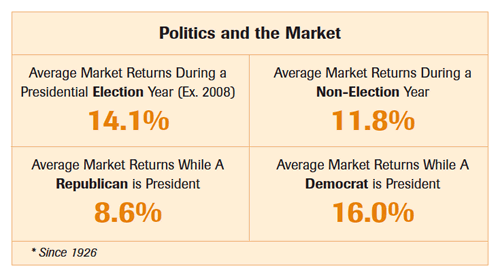2012 Q3 | Approaching Crunch Time
 Economically, the doldrums settled in this summer. This is not altogether surprising considering the myriad issues confronting countries all over the world. The European financial crisis, the Fiscal Cliff, and the Presidential election are all weighing on the minds of corporate and government leaders. As we approach crunch time for these major events, rhetoric has increased and economic activity has slowed. During the quarter, U.S. economic activity stumbled along at a growth rate of less than 2%. This frustrating performance resulted in a continuation of high levels of unemployment and a significant number of workers who have ceased looking for work. This subset of discouraged workers, known as “Series U-6,” has now reached 6.6% of the workforce, and when added to the official unemployment rate of 8.1%, results in a level of 14.7%. While U-6 has improved, it is still unacceptably high.
Economically, the doldrums settled in this summer. This is not altogether surprising considering the myriad issues confronting countries all over the world. The European financial crisis, the Fiscal Cliff, and the Presidential election are all weighing on the minds of corporate and government leaders. As we approach crunch time for these major events, rhetoric has increased and economic activity has slowed. During the quarter, U.S. economic activity stumbled along at a growth rate of less than 2%. This frustrating performance resulted in a continuation of high levels of unemployment and a significant number of workers who have ceased looking for work. This subset of discouraged workers, known as “Series U-6,” has now reached 6.6% of the workforce, and when added to the official unemployment rate of 8.1%, results in a level of 14.7%. While U-6 has improved, it is still unacceptably high.
In spite of these pending issues, our economy continues to push ahead, albeit at a slower-than-desired rate. This, however, is much better than many other parts of the world. Cracks appeared in the great Chinese economic wall, yet Asia as a whole maintained reasonable forward momentum. The same cannot be said for Europe. Finance ministers grappled with lingering effects of excessive borrowings that violated many countries’ pledges for responsible fiscal policies that were accepted as a condition of joining the Euro. Although European economic growth proved disappointing, we sense the financial challenges did not worsen during the quarter.
The real key to a sustained European recovery will be found when a compromise can be reached between the wealthy Northern members of the European Union (Germany, Norway, Sweden, and the Netherlands) and the needy Southern nations (Italy, Spain, and Greece). The delicate balancing act of extending credit to the economically weak nations in return for real austerity measures while preserving political stability has proven to be a very elusive goal to date, as governments in Greece and France have already been ousted. Though this challenge is complex, a failure would result in an even sharper reduction in living standards of many of our European friends.
European leaders would do well to acknowledge that economic recoveries tend to mirror the degree of excess that preceded them. By way of comparison, the U.S. economy was quick to shake off a shallow recession in 1991-92, and even the tech-related crash and recession of 2001-02 was not extreme in its severity. On the other hand, the 1930s Depression and the 2008-09 recession were major economic events that have or will require a much longer period for full recovery. Viewed in this context, the current slow recovery makes sense.
One of the more surprising developments during the quarter occurred after a gathering of senior economic officials in Jackson Hole, Wyoming in September. The Federal Reserve decided to embark on a third significant monetary easing (QE3) in order to stimulate the economy. Fed Chairman Bernanke declared he will add $40 billion of monetary stimulus every month until the employment rate improves. Further, he vowed to maintain current interest rates into 2015. When QE3 is completed, we are concerned that the Federal Reserve’s balance sheet will stand at $4 trillion, as compared to ~$900 billion in 2008 when the program started.
Quantitative easing is a very blunt tool used to stimulate the economy. Their sharpest tool, of course, is interest rates, but we can’t go lower than zero. Injecting liquidity into the system was attempted during the Depression, and it failed. Then, citizens literally put money in their mattresses by hoarding physical gold until FDR outlawed private ownership of gold in 1933. However, Richard Nixon restored legal gold ownership rights to U.S. citizens in his economic tsunami of 1971.
——————————————————————-
Their sharpest tool, of course, is interest rates, but we can’t go lower than zero.
——————————————————————-
With the Federal Reserve Bank focused on stimulating the economy and virtually no effective tools at their disposal, it seems almost surreal that the Administration and Congress have reached a budgetary stalemate that threatens the recovery itself. Failure of the “super committee” to structure a “grand bargain” last fall now threatens the nation with huge tax increases and substantial budgetary sequestration issues all scheduled to hit on January 1, 2013. Commonly referred to as the “Fiscal Cliff,” the Congressional Budget Office estimates that this potential Faustian horror would lower the 2013 Gross Domestic Product by almost four percentage points (~$670 billion) and almost certainly trigger a recession in 2013. One wonders when the economic statesmen will end this silly game of political chicken that could result in great damage to both the fragile U.S. economic recovery and extend economic challenges to our trading partners around the world. Winston Churchill said, “You can always count on Americans to do the right thing, after they’ve tried everything else.” We hope and expect this will be the case in the present budgetary impasse.
Our current thinking is that the Bush tax cuts will be extended with some increases at the upper income levels. We also believe most of the budgetary sequestration measures will be delayed for several months, allowing the new Congress to take office in January and attempt to forge a permanent solution. If today’s political children don’t start behaving as adults, the consequences will not be pleasant.
In addition to the budgetary issues, America is facing a presidential election on November 6. For several election cycles, the rhetoric between parties has become shrill and venomous to the point that threatens a return to civility after the election. Presidential election years have generally been excellent for performance in the stock market, when excluding 2008. In fact, after making this adjustment, stocks were up an average of 14.14% vs. 11.82% during non-presidential years since 1926. Actually, the stock market’s performance over many administrations has favored Democratic control of the White House (see table). We feel strongly that the financial markets reflect the outlook for future levels of earnings and inflation. On that score, we remain optimistic, regardless of which party wins in November.

In a world confronting too many problems to enumerate, the financial markets turned in a stellar performance in the quarter and year-to-date. For the quarter, the S&P gained 6.4%, representing the best third quarter since 2010. Somewhat surprisingly, the equity results were achieved as nearly every week money flowed out of equity mutual funds and into government and corporate bond funds. Some feel the strong performance in September, usually a bad month for stocks, was driven by hedge funds that were significantly underinvested in equities, trying frantically to close a major performance deficit for the year to date. If anything, these reactionary market movements underscore our firm’s less emotional value approach. Some have labeled us as the tortoises of the investment community. We welcome the comparison.
We continue to be cautious of bonds with maturities longer than five years. Inflation in general is projected to be around 2%, so when compared to the 1.7% current yield on U.S. government 10-year bonds, the investor is actually earning a negative return (1.7% yield minus inflation of 2.0% = -0.3% per year). The bond moons rarely align themselves in this way, and when they have, bond investment returns have not been very satisfactory.
Finally, in talking to many young people, I could become depressed with tales of newly-minted graduates from highly respected colleges and universities unable to find work in their chosen fields. Some of the problems result from the great numbers who have pursued academic careers that have recently been economically the most rewarding—those in finance, law, and the newer “jackpot careers” in hedge funds, private equity firms, and the investment banking field. Just as investment advisors chasing last year’s winning strategies often come up short in the performance derby, many of today’s very intelligent students are finding they hit the goldmine career stations after the train left. Of course, as in all cycles, eventually these imbalances will correct, and hopefully they will do so soon.
——————————————————————-
If today’s political children don’t start behaving as adults, the consequences will not be pleasant.
——————————————————————-
Easy for me to say, rounding the bend to the final stretch of my career. But in looking back, there have been many shifts in the employment markets over my working lifetime, and this will certainly continue in the future. There will always be a solid future for those who are educated and willing to work, and careers in healthcare, information technology, engineering, energy, and financial services all offer promise in the immediate future. As an aging American demographic moves the rudder of economic activity to a new course, new career opportunities in innovative technologies will accompany a new generation to prosperity.
On a sad note, one of both this firm’s and my own oldest friends in the investment industry, Gregory Barnhill, died unexpectedly on September 16. I had known Greg since July of 1978, and watched proudly as he scaled not just the heights of Baltimore’s investment community, but became a recognized figure in financial centers around the world. He gave much to our city, and he will be greatly missed. Our heartfelt sympathies go to his dear wife Lisa and their wonderful son, Scotty.



